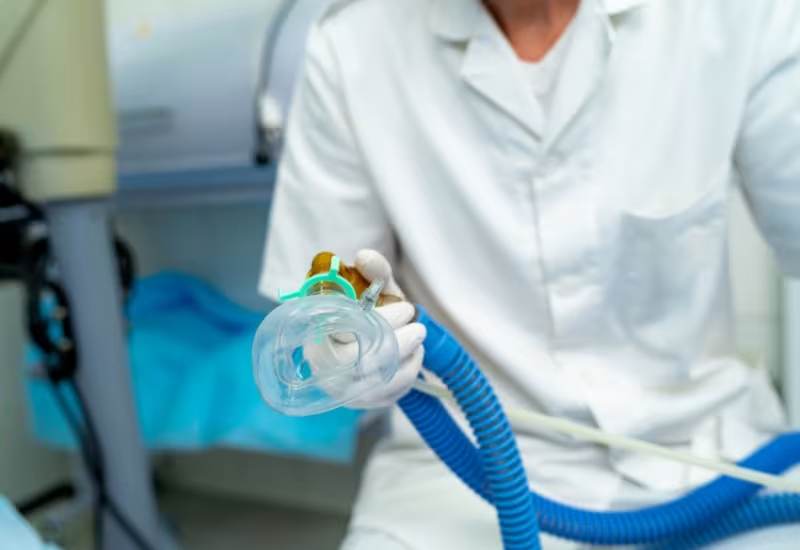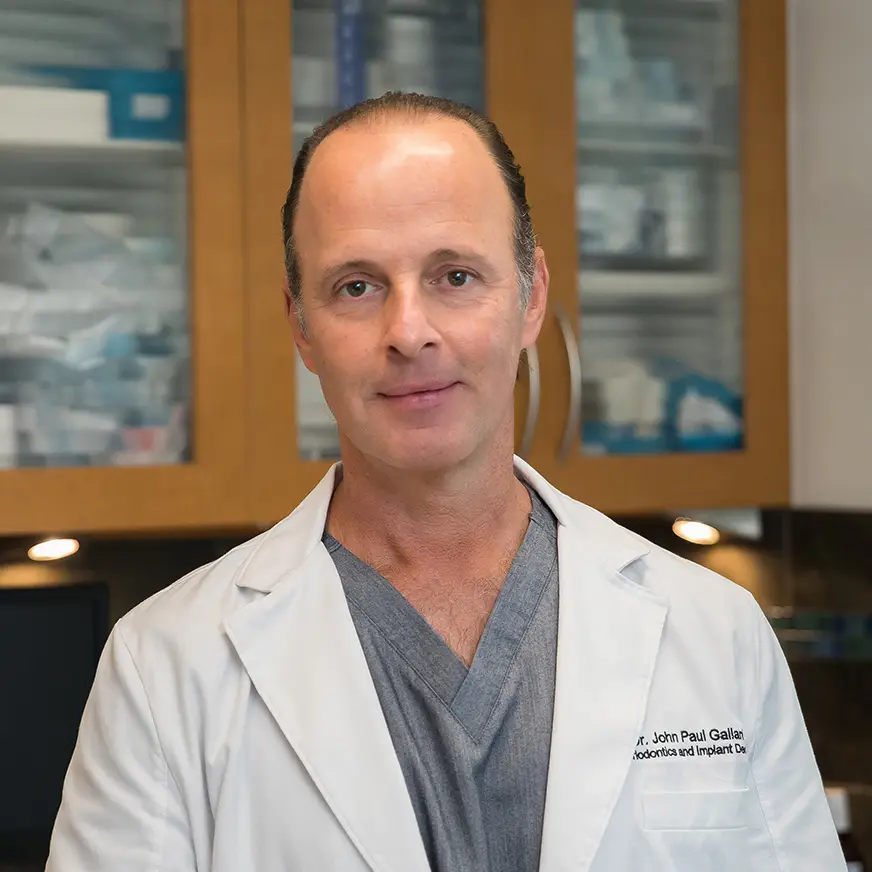Home / Dental Services / Sedation Dentistry
Sedation Dentistry Miami, FL
Dr. John Paul Gallardo, a top Miami periodontist, offers safe, effective sedation options to ensure stress-free, comfortable care. With expertise in advanced sedation techniques, Dr. Gallardo helps even the most nervous patients relax and feel at ease during treatment. Gallardo Periodontal and Implant Dentistry, located in Miami, FL, has specialized training and certification in sedation dentistry.
The Advantages of Dental Sedation
- No More Anxiety: Feel relaxed and calm—no more dental fear.
- Time Flies: Your appointment will feel quick and easy.
- Tailored Comfort: Dr. Gallardo will choose the perfect sedation level for your needs.
- Perfect for Complex Treatments: Stay relaxed while Dr. Gallardo handles more complex treatments in fewer visits.
- Wide range of sedation options: Delivered by our team using cutting-edge technology and best practices.
What is Sedation Dentistry?
Sedation dentistry is a specialized branch of dental care that utilizes medication to help patients relax during dental procedures. It’s an effective approach to alleviating dental fear, dental anxiety and discomfort associated with dental treatments, making dental visits more comfortable and stress-free.
From simple dental cleanings to more complex procedures like dental implants or root canal therapy, sedation dentistry can be employed to enhance the patient’s experience and improve the efficiency of the procedure.

Multiple Levels of Sedation Dentistry
Different levels of sedation can be used in dentistry, and the choice depends on the patient’s needs and the complexity of the dental procedure.
The sedation levels range from mild relaxation, where the patient remains conscious but relaxed, to deep sedation, where the patient is on the edge of consciousness but can still be awakened. The highest level is general anesthesia, where the patient is completely unconscious.
Each level of sedation provides different degrees of anxiety relief and pain management to make every patient feel comfortable. The most common include conscious sedation (where the patient remains awake), general anesthesia (also called Deep Sedation, the patient is asleep throughout the procedure) and intravenous sedation (IV).
Your Comfort is Our Priority
At Gallardo Periodontics, we specialize in gentle, stress-free care through sedation. Our tailored sedation options ensure every patient can relax and feel comfortable during their dental visit.
Sedation Dentistry Candidates
Sedation dentistry helps Dr. Gallardo manage his Miami patients with anxiety or fear of dental treatments, particularly those who:
- High fear of needles or going to the dentist
- Traumatic dental experiences
- Difficulty getting numb
- Significant gag reflex
- Very sensitive teeth
- Complex dental problems
- Limited time to complete dental care
- Are bothered by the noises, smells and taste associated with dental care/oral health
Types of Sedation Used in Dentistry
Each of these sedation methods has its own unique advantages, catering to different patient needs, preferences, and specific dental procedures. By offering a range of sedation options, dental professionals can provide a more personalized and comfortable dental care experience.
Oral Sedation
Oral Sedation Benefits:
- Easy to administer, as it only requires the patient to take a pill.
- Non-invasive, with no needles or IV lines required.
- The level of sedation can be adjusted by altering the medication dosage, providing flexibility in managing patient comfort.
- Significantly reduces anxiety and fear, making it ideal for patients with mild to moderate dental anxiety.
IV Conscious Sedation Dentistry
IV Conscious Sedation Benefits:
- Offers a deeper level of sedation compared to oral sedation, making it suitable for patients with more significant anxiety or for longer procedures.
- The dentist has precise control over the sedation level, allowing for immediate adjustments for patient comfort.
- Effects are felt quickly, making it efficient for immediate relaxation.
Computer-Generated Anesthesia
Computer-Generated Anesthesia Benefits:
- Provides highly accurate and controlled delivery of anesthesia.
- Reduces the likelihood of excessive numbness or discomfort post-procedure.
- Ideal for patients requiring localized anesthesia with a fear of needles.
Inhalation Conscious Sedation/Nitrous Oxide
Nitrous Oxide Sedation Benefits:
- Has a rapid onset and recovery time, allowing patients to drive themselves home after the procedure.
- The level of sedation can be easily adjusted throughout the procedure.
- Considered very safe with minimal side effects, making it a preferred option for many patients.
What Our Patients Say
Committed to your results

The Sedation Dentistry Process
With dr. Gallardo
The sedation dentistry process at Gallardo Periodontics and Implant Dentistry begins with an initial consultation, where Dr. Gallardo will assess your dental needs, anxiety levels, and medical history to determine the most appropriate sedation method for you.
Before the procedure, the chosen sedation method will be administered, making you comfortable and relaxed throughout the treatment.
Dr. Gallardo and his professional staff are highly trained and licensed in administering sedatives and will closely monitor your vital signs to ensure your safety. Once the dental procedure is complete, you will be given time to recover in the office before being discharged with post-operative care instructions.
Recovering After Sedation Dentistry
Cost of Sedation Dentistry in Miami, FL
The cost of sedation dentistry in Miami, FL, can vary and depends on the type of sedation used, the complexity of the dental procedure, and the duration of the treatment.
At Gallardo Periodontics and Implant Dentistry, the team strives to provide affordable and high-quality sedation dentistry services to patients. You can discuss your financial concerns during your initial consultation, as the clinic offers various payment options and financing plans to suit your budget.

Why Choose Gallardo Periodontics for Sedation Dentistry in Miami, FL?
Dr. John Paul Gallardo is a distinguished periodontist and dental implant specialist with 30 years of experience. Opting for Dr. Gallardo’s expertise in sedation dentistry services in Miami, FL, provides numerous benefits:
- Exceptional skill in sedation techniques, ensuring patient comfort and ease during procedures.
- A cutting-edge facility that prioritizes safe and effective care with minimal recovery time.
- Renowned for offering IV conscious sedation, making him a rare provider in South Florida.
- Actively engaged in professional circles, including affiliations with the University of Florida, Florida Association of Periodontists, and North American Society of Periodontists.
- Recognized by prominent media outlets, such as the Miami Herald and Univision, for his contributions to oral health discussions.
- A mentor to dental students at the University of Florida, and the founder of an elite doctor study club focused on the latest developments in implant dentistry.
Choosing Gallardo Periodontics for your sedation dentistry needs in Miami means entrusting your care to a leader in the field, committed to excellence in patient experience and clinical outcomes.
IV Sedation FAQs
What is IV sedation?
IV sedation, or intravenous sedation, involves administering sedative medications directly into your bloodstream to produce a calming, relaxing, or sleep-inducing effect. It is widely used in both general and cosmetic dentistry to provide a more efficient and effective treatment session without pain or anxiety.
Are there any side effects of IV Sedation?
Most side effects of IV sedation are either desirable, such as amnesia regarding the procedure, or residual, like continued sleepiness for several hours afterward. Occasionally, there may be problematic drug interactions, so it’s important to discuss your other medications with your dentist before the procedure.
How much does IV sedation cost in Miami?
The cost of IV sedation in Miami varies depending on the complexity of the dental procedure and the duration of the treatment. It’s essential to discuss your financial concerns during your initial consultation, as Gallardo Periodontics and Implant Dentistry offers various payment options and financing plans to suit your budget.
Is IV sedation dentistry covered by insurance?
Some dental insurance plans may cover a portion of the IV sedation dentistry costs. Before scheduling your appointment, check with your insurance provider to understand your coverage and potential out-of-pocket expenses.
What will I experience after receiving IV sedation?
Most patients become very calm and relaxed shortly after IV sedation begins. Depending on the dosage, you may find yourself relatively alert or very sleepy. In most cases, IV sedation will make the time seem to pass very quickly and will likely leave you unable to remember much or all of the procedure.
What special training should my doctor and the staff have in order to administer IV Sedation?
In most areas, dentists who administer IV sedation are required to be specially trained or hold specific permits. There are private organizations like DOCS Education that provide comprehensive training in IV sedation techniques. Often, the entire dental team is also required to have training in IV sedation to adequately monitor patient care and respond to any potential emergencies.
Do patients need to prepare for IV sedation?
You’ll typically need to avoid food and water for several hours before the procedure. You will also need to arrange for someone to drive you to and from your appointment, since you may be too groggy to drive safely after your visit. During your initial consultation, we will fully review the steps you’ll need to take before your IV sedation dentistry procedure.
What will the recovery be like after IV sedation?
In most cases, patients should plan to take the remainder of the day to rest and recover, although the exact length of time will depend on both the IV sedation and the procedure. You’ll need to avoid driving or operating machinery for a full 24 hours in most cases, and you should take particular care to remain hydrated.
What sedation dentistry Miami office is near me?
If you live near Miami, FL, Gallardo Periodontics and Implant Dentistry offers sedation dentistry among its services, and is conveniently located at 2020 SW 27th Ave Miami, FL 33145